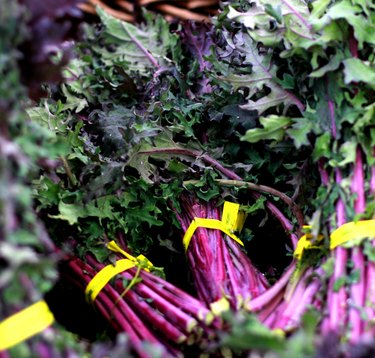
Red Russian kale originated in Siberia and made its way to North America via traders in the late 1800s. With its blue-green leaves and reddish-purple veins, red kale is so jam-packed with beneficial nutrients it is often dubbed a "super food." Eating red kale regularly may have wide-ranging benefits such as promoting eye and heart health and preventing cancer. Enjoy it steamed or sauteed, or use it raw in smoothies and salads.
Overall Nutrition
Video of the Day
Red kale is a low-calorie, low-carb, low-fat food that also supplies protein. An 85-gram serving, or about 3 ounces, has 45 calories. Of the 9 grams of carbohydrates in a serving, 2 grams are from dietary fiber, which improves digestive health and keeps you feeling full longer. A serving of kale has less than a gram of fat, 3 grams of protein, 35 milligrams of sodium and no sugar.
Video of the Day
Other Nutrients
A serving of red kale gives you 260 percent of the daily value for vitamin A and 170 percent of the DV for vitamin C, based on a 2,000-calorie diet. Along with the phytonutrients lutein and zeaxanthin, which are also found in generous amounts in kale, vitamin A supports healthy eyesight, especially as you age. The lutein in kale has potential benefits for heart health, too, by preventing plaque formation in the arteries, according to one test-tube study. Vitamin C is an antioxidant that fights cell damage from free radicals, which can build up and lead to chronic illness. A serving of kale also gives you small amounts of calcium and iron.